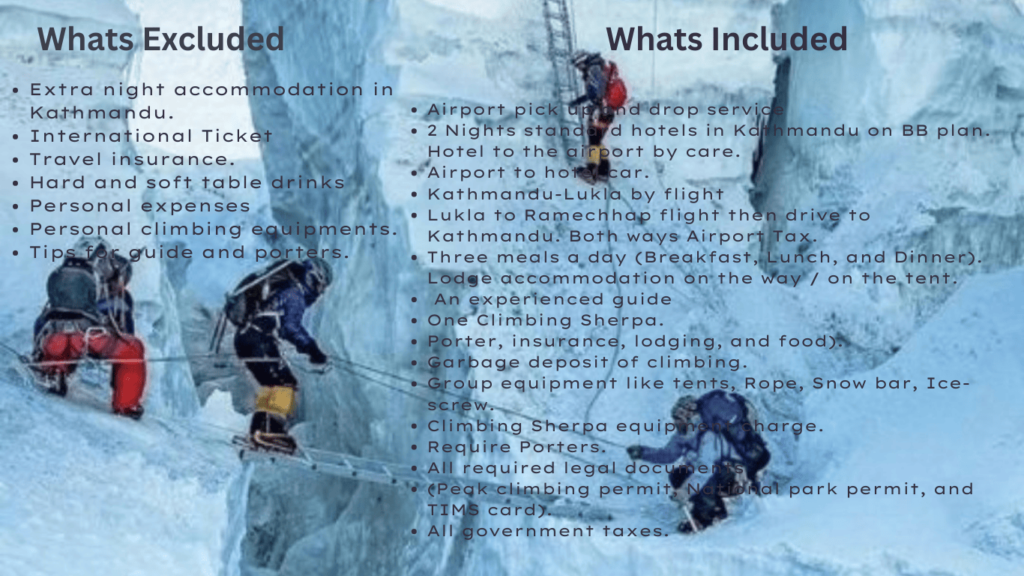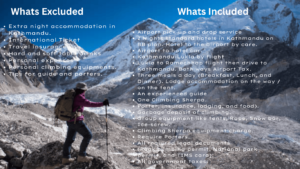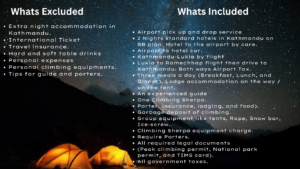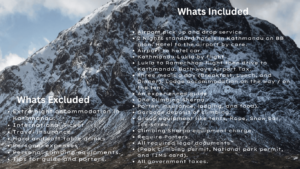Everest Expedition Cost | Everest Climbing Cost and Season | Train For Everest

Mount Everest Expedition Cost:
Spring Date: $39,000 = 6 April to 4 June 2023, 2024 and 2025
Autumn Dates: $48,000 = 20 August to 20 October 2023, 2024 and 2025
Everest Base Camp Trek
Upon reaching Lukla, your trek commences towards the village of Phakding (2600 m/8550 ft), located near the river, where you can have a pleasant overnight stay.
Following this, you will ascend a considerable hill to reach Namche Bazaar, which is the primary trading hub of the Sherpas. Your accommodation for the night will be in the lodge.
Namche is a fun town to hang out in, so we can take a rest day here. We can walk to the hotel and see Everest, Lhotse, Nuptse, and Ama Dablam, then walk down into town for pizza or cake (if possible).
Next, we walk along ridges and rivers to Pangboche (3950 m/12,950 ft), the old summer capital of Sherpa yak herders. We stay in a gorgeous lodge near the river.
Now we have a short walk to Dingboche at 4400 meters (14,450 feet), which has some barley growing nearby. In Dingboche, we can take a “rest” day at a warm lodge and climb up to 5000 meters (16,500 feet) on a ridge above town for acclimatization purposes—there are lovely views up here of Ama Dablam, Pumori, Nuptse, Lhotse… amazing!
Our next stop is Lobuche, at 4950 meters (16,250 feet), in a very cozy lodge. In fact, Lobuche is our last stop before we go directly from here to base camp, passing through the outpost of 5050 m (16,550 ft) at Gorakshep for lunch. Finally, we reach our Everest Base Camp at 5300m (17,400 ft).
We will establish a very comfortable camp in the base camp. Here you can find separate private sleeping tents, dining tents, toilet tents, shower tents, and good wifi in basecamp. You will be doing a lot of fixed-rope ice-climbing training. From the ice pinnacles, various ascending and descending techniques can be learned in the base camp.
Mount Everest Climb
Everest Camp 1
Camp 1 lies at 6,100 meters, which is equal to 20,000 feet.
It’s located in Western China, and Western China lies at the heart of Everest.
going through the Khumbu icefall, crossing and climbing ladders, and climbing up in order to reach Camp 1.
It takes about 4-6 hours to reach Camp 1 from the Everest base camp.
Everest Camp 2
At 20,750 feet (6350 meters), Camp 2 is located.
From Western Camp, reach Camp 2. It takes about 4-5 hours to reach Camp 2 from Camp 1.
To prepare for the next stage of the climb, which involves climbing the Lhotse Face. We will be reaching the west face of Mount Everest.
Finally, when we have full energy and stamina, we need to move towards camp 3.
Everest Camp 3
Camp 3 is located at an altitude of 7,470 meters (24,500 feet).
It takes about 6–8 hours to reach Camp 3 from Camp 2.
The terrain is steep and icy, and climbers need to navigate through the Lhotse Face, which is a wall of ice that rises up to 1,125 meters (3,690 feet).
Camp 3 is a small campsite with basic facilities. There are several tents set up for climbers to sleep in and a small kitchen area where hot meals are prepared.
The main purpose of Camp 3 is to acclimatize to the high altitude and prepare for the summit push.
Everest Camp 4
Camp 4 lies at an elevation of 26,000 feet, which is equivalent to 7950 meters.
From here, we will be ascending South Col, where we will use oxygen tanks to climb the Lhotse Face before transitioning to a much easier rock scramble called the Yellow Band.
At this peak altitude, carrying the necessary equipment to climb Everest, the difficulty level is quite high.
After scaling the Yellow Band, our next step is to cross over the rocky ridge on the Geneva Spur of the Lhotse Face, affording us stunning views despite the cold and windy conditions.
This will lead us to the South Col, a vast, flat expanse of snow that is situated on the border between Nepal and Tibet.
During our time at Camp 4, we must be sure to replenish our oxygen tanks and take time to rest in the South Col for a 24-hour period.
As part of our recovery process, we must stay hydrated with hot beverages such as tea and soups.
Climb Everest: Summit Attempt
We will climb through the night up the slopes of Everest, which loom above the South Col.
We will change oxygen bottles as necessary; upon reaching the top of the face, we will change oxygen again at 8500 meters (27,880 feet) and keep going up the ridge to reach the South Summit at 8750 meters (28,700 feet).
Here we get our first really good look at The Hillary Step, which is a half-block long row of rock gendarmes splayed out along the ridge with one large 12-meter (40-foot) high buttress cliff at its far end.
How To Reach
To start the journey, you must take a flight from Kathmandu (an altitude of 1850 meters or 6050 feet) to Lukla (an altitude of 2800 meters or 9250 feet). In favorable weather conditions, the mode of transportation is usually an airplane with a seating capacity of 16 passengers.
Best Time To Visit And Climate
Spring Time On Everest: April and May
The period before the monsoon season is commonly referred to as spring time on Everest. In this season, March marks the inception of the thawing process, sometimes with intermittent snowfall. Subsequently, April and May are characterized by warmer weather and the occurrence of spring-related conditions such as cloudy and snowy storms. Additionally, there will be sunny periods, and it is hoped that several weeks of bright weather will be experienced in May when the days are longer, warmer, and opportune for a summit bid.
Autumn On Everest: Late September, October, and November
The monsoon rains and blizzards usually subside during the months of September, October, and November. In high altitudes, the snowfall decreases in September, especially toward the end of the month. As October approaches, the days get sunnier and less wet, making it a great time for autumn mountaineering. However, towards the end of October, the winter winds pick up again, and November tends to be a bitterly cold and windy month at the top of Everest.
Preparing for Everest: Tips for Effective Training
Start With Cardiovascular Training
For building endurance and stamina, cardiovascular training is important for climbing Everest.
Do exercises such as walking, jogging, or cycling, and gradually increase the intensity and duration of your workouts.
Strength Training
Strength training is important for climbing Everest. Focusing on building some strength in your legs, core, and upper body will be advantageous.
Train At High Altitudes
Climbing Everest needs to be favorable at a high altitude. As you climb higher and higher, the air becomes quite thin. It makes it harder to breathe.
To prepare for this, you should train at high altitudes. Climb other mountains like Island Peak, Lobuche, and Ama Dablam for high altitudes.
FAQ
What is the experience of scaling Mount Everest like?
The journey of climbing this mountain is both difficult and gratifying. Hikers must trek for more than a week to reach the base camp, then spend several weeks ascending the lower sections of the mountain and returning to base camp to adjust to the high altitude. The weather conditions can vary from sunny and warm days to harsh cold and strong winds. Climbers need to be physically and mentally prepared for a 60-day expedition in a remote location, and also have the necessary skills and equipment to climb at such extreme heights.
Why should I consider embarking on this journey?
Every climber has their own personal reasons for attempting Mount Everest, but it is widely agreed that there are numerous compelling reasons to do so. Of course, reaching the highest point on Earth is a remarkable achievement and a highlight in many climbers’ careers. The views from the summit are unmatched, the Nepali/Sherpa culture is incredible, and the Everest region is one of the most breathtaking places in the world. Above all, most climbers would attest that conquering Everest is the ultimate way to challenge oneself and push their limits in one of the most extreme locations on Earth.
Is it worth the effort to conquer Mount Everest? What makes it so expensive to climb?
The majority of those who have reached the summit would agree that the time and money invested was well worth it. The cost of climbing Mount Everest is high due to the extensive logistics required for a 60-day expedition in Nepal. The climbing permit alone costs $11,000 per person. Even a small team attempting the climb requires a large support staff, including leaders, Sherpa guides, cooks, and dozens of porters to carry thousands of pounds of equipment to base camp. In addition, outfitters must also cover expenses such as insurance for the company and staff, flights to Lukla, hundreds of meals for climbers and staff, and top-of-the-line climbing gear.
How do people manage to conquer Everest? How do some climbers do it without using supplemental oxygen?
The use of bottled oxygen is what enables the majority of climbers to reach the summit. Using oxygen canisters allows for faster movement and helps climbers stay warm. It is possible to climb Everest without supplemental oxygen, but this should only be attempted by the most elite athletes, and even then, their success rate is extremely low. More than 5,000 people have successfully reached the summit of Everest, with over 95% of them using supplemental oxygen.
How long does it take to climb Mount Everest 8848?
It takes almost 60 days to climb mount Everest.




